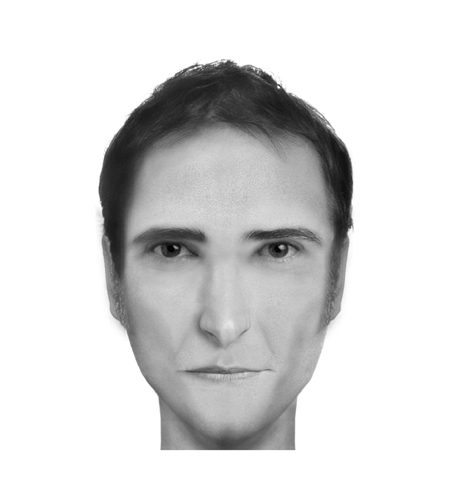Art and science may seem like distinctly separate areas of study but, when they come together, it can be a beautiful thing. In fact, art can be used to boost STEM (science, technology, engineering, and math) education, and STEM can even be used to create art.
That’s what digital artist Brian Joseph Davis did when he created the series The Composites. Combining art and technology, Davis is creating realistic images of popular book characters using law enforcement composite sketch software. He uses the detailed character descriptions found in the novel to create the life-like images.
Take a look at some of the images he’s created and the books’ descriptions of the characters below and see which ones match the image you formed when you read the book.
[embedvideo id=”HJPExutb9QU” website=”youtube”]
Sherlock Holmes, A Study in Scarlet, Sir Arthur Conan Doyle
His very person and appearance were such as to strike the attention of the most casual observer. In height he was rather over six feet, and so excessively lean that he seemed to be considerably taller. His eyes were sharp and piercing, save during those intervals of torpor to which I have alluded; and his thin, hawk-like nose gave his whole expression an air of alertness and decision. His chin, too, had the prominence and squareness which mark the man of determination.
Daisy Buchanan, The Great Gatsby, F. Scott Fitzgerald
Her face was sad and lovely with bright things in it, bright eyes and a bright passionate mouth . . . a conscientious expression . . . Slenderly, languidly . . . an expression of unthoughtful sadness . . . her cheeks flushed . . . she looked at me with an absolute smirk on her lovely face as if she had asserted her membership in a rather distinguished secret society . . . a bright ecstatic smile . . . Aching, grieving beauty . . . For Daisy was young and her artificial world was redolent of orchids and pleasant, cheerful snobbery . . . A damp streak of hair lay like a dash of blue paint across her cheek . . . “She doesn’t look like her father,” explained Daisy. “She looks like me. She’s got my hair [yellowy] and shape of the face.”
Now and then she moved and he changed his arm a little and once he kissed her dark shining hair.
Girls were swooning backward playfully into men’s arms, even into groups knowing that some one would arrest their falls—but no one swooned backward on Gatsby and no French bob touched Gatsby’s shoulder.
The Strange Case of Dr. Jekyll and Mr. Hyde, Robert Louis Stevenson
To this rule, Dr. Jekyll was no exception; and as he now sat on the opposite side of the fire—a large, well-made, smooth-faced man of fifty, with something of a slyish cast perhaps, but every mark of capacity and kindness . . . The large handsome face of Dr. Jekyll grew pale to the very lips, and there came a blackness about his eyes.
Mr. Hyde was pale and dwarfish, he gave an impression of deformity without any nameable malformation, he had a displeasing smile . . . thickly shaded with a swart growth of hair . . . corded and hairy…God bless me, the man seems hardly human! Something troglodytic…Edward Hyde was so much smaller, slighter, and younger than Henry Jekyll. Even as good shone upon the countenance of the one, evil was written broadly and plainly on the face of the other . . . The few who could describe him differed widely, as common observers will. Only on one point, were they agreed; and that was the haunting sense of unexpressed deformity with which the fugitive impressed his beholders.
Rachael Rosen, Do Androids Dream of Electric Sheep?, Philip K. Dick
When he landed the police department hovercar on the roof of the Rosen Association Building in Seattle he found a young woman waiting for him. Black-haired and slender, wearing the new huge dust-filtering glasses . . . She had, on her sharply defined small face, an expression of sullen distaste. She eyed him from beneath long black lashes, probably artificial . . . Rachael’s proportions, he noticed once again, were odd; with her heavy mass of dark hair her head seemed large, and because of her diminutive breasts her body assumed a lank, almost childlike stance. But her great eyes, with their elaborate lashes, could only be those of a grown woman . . . Some female androids seemed to him pretty; he had found himself physically attracted by several.
Dallas Winston, The Outsiders, S.E. Hinton
If I had to pick the real character of the gang, it would be Dallas Winston—Dally. I used to like to draw his picture when he was in a dangerous mood, for then I could get his personality down in a few lines. He had an elfish face, with high cheekbones and a pointed chin, small, sharp animal teeth, and ears like a lynx. His hair was almost white it was so blond, and he didn’t like haircuts, or hair oil either, so it fell over his forehead in wisps and kicked out in the back in tufts and curled behind his ears and along the nape of his neck. His eyes were blue, blazing ice, cold with a hatred of the whole world. Dally had spent three years on the wild side of New York and had been arrested at the age of ten. He was tougher than the rest of us—tougher, colder, meaner. The shade of difference that separates a greaser from a hood wasn’t present in Dally.
Julia, Nineteen Eighty-Four, George Orwell
He did not know her name, but he knew that she worked in the Fiction Department . . . She was a bold-looking girl, of about twenty-seven, with thick hair, a freckled face, and swift, athletic movements . . . It was the girl from the Fiction Department, the girl with dark hair. The light was failing, but there was no difficulty in recognizing her . . . ‘Would you believe,’ he said, ‘that till this moment I didn’t know what colour your eyes were?’ They were brown, he noted, a rather light shade of brown, with dark lashes . . . The youthful body was strained against his own, the mass of dark hair was against his face, and yes! Actually she had turned her face up and he was kissing the wide red mouth . . . With just a few dabs of colour in the right places she had become not only very much prettier, but, above all, far more feminine. Her short hair and boyish overalls merely added to the effect . . . ‘They can’t get inside you,’ she had said. But they could get inside you . . . Her face was sallower, and there was a long scar, partly hidden by the hair, across her forehead and temple.
What do you think your favorite literary character looks like? Which character would you want to see sketched out? Share your thoughts below.




























































































































